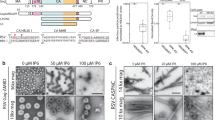Abstract
The product of the Rous sarcoma virus (RSV) transforming gene, src, is a phosphoprotein of molecular weight (Mr) 60,000 (pp60src)1–3 that is responsible for cell transformation as well as fibrosarcoma formation in a variety of animals4,5. Several experiments suggest that pp60src is a protein kinase6–10 with the unusual capacity of phosphorylating tyrosine residues11,12, but additional evidence would be of value. Earlier studies had suggested that bacteria were unable to carry out protein phosphorylation13, although more recent findings indicate that distinct protein kinases and phosphatases are present in Salmonella typhimurium14. Despite this observation, because of the evolutionary distance, the enzymatic activities observed in bacteria are likely to be carried out by proteins unrelated to those expressed in eukaryotic cells. Thus, to study the RSV transforming protein synthesized in the absence of the variety of protein kinases expressed in normal host cells (for reviews see refs 15, 16), we have now constructed plasmids that express p60src in Escherichia coli. Analysis of p60src produced in E. coli and selected by immunoaffinity chromatography, shows that it has the capacity to phosphorylate proteins at tyrosine residues; this activity is specifically inhibited by anti-p60src IgG. Extracts from E. coli carrying identical plasmids but lacking the src gene yield no detectable enzyme activity. These data, taken with those previously published9,10,17, lead to the conclusion that the RSV src gene encodes a protein kinase.
This is a preview of subscription content, access via your institution
Access options
Subscribe to this journal
Receive 51 print issues and online access
$199.00 per year
only $3.90 per issue
Buy this article
- Purchase on Springer Link
- Instant access to full article PDF
Prices may be subject to local taxes which are calculated during checkout
Similar content being viewed by others
References
Brugge, J. S. & Erikson, R. L. Nature 269, 346–348 (1977).
Purchio, A. F., Erikson, E. & Erikson, R. L. Proc. natn. Acad. Sci. U.S.A. 74, 4661–4665 (1977).
Purchio, A. F., Erikson, E., Brugge, J. S. & Erikson, R. L. Proc. natn. Acad. Sci. U.S.A. 75, 1567–1571 (1978).
Hanafusa, H. Comprehensive Virol. 10, 401–83 (1977).
Vogt, P. K. Comprehensive Virol. 9, 341–455 (1977).
Collett, M. S. & Erikson, R. L. Proc. natn. Acad. Sci. U.S.A. 75, 2021–2024 (1978).
Levinson, A. D., Oppermann, H., Levintow, L., Varmus, H. E. & Bishop, J. M. Cell 15, 561–572 (1978).
Rubsamen, H., Friis, R. R. & Bauer, H. Proc. natn. Acad. Sci. U.S.A. 76, 967–971 (1979).
Erikson, R. L., Collett, M. S., Erikson, E. & Purchio, A. F. Proc. natn. Acad. Sci. U.S.A. 76, 6260–6264 (1979).
Erikson, R. L., Collett, M. S., Erikson, E., Purchio, A. F. & Brugge, J. S. Cold Spring Harb. Symp. quant. Biol. 44, 907–917 (1979).
Hunter, T. & Sefton, B. M. Proc. natn. Acad. Sci. U.S.A. 77, 1311–1315 (1980).
Collett, M. S., Purchio, A. F. & Erikson, R. L. Nature 285, 167–169 (1980).
Rubin, C. S. & Rosen, O. M. A. Rev. Biochem. 44, 831–887 (1975).
Wang, J. Y. J. & Koshland, D. E. Jr J. biol Chem. 256, 4640–4648 (1981).
Cohen, P. Curr. Topics cell. Regulation 14, 117–196 (1978).
Krebs, E. G. & Beavo, J. A. A. Rev. Biochem. 48, 923–959 (1979).
Levinson, A. D., Oppermann, H., Varmus, H. E. & Bishop, J. M. J. biol. Chem. 255, 11973–11980 (1979).
Collett, M. S., Erikson, E. & Erikson, R. L. J. Virol. 29, 770–781 (1979).
Karess, R. E. & Hanafusa, H. Cell 24, 155–164 (1981).
Gilmer, T. M., Parsons, J. T. & Erikson, R. L. Proc. natn. Acad. Sci. U.S.A. (submitted).
Backman, K., Ptashne, M. & Gilbert, W. Proc. natn. Acad. Sci. U.S.A. 73, 4174–4178 (1976).
Highfield, P. E., Rafield, L. F., Gilmer, T. M. & Parsons, J. T. J. Virol. 36, 271–279 (1979).
Chamberlin, J. P. Analyt. Biochem. 98, 132–136 (1979).
Bechtel, P. J., Beavo, J. A. & Krebs, E. G. J. biol. Chem. 252, 2691–2697 (1977).
Sloboda, R. D. et al. Cold Spring Harb. Conf. Cell Proliferation 3, 1171–1212 (1976).
Author information
Authors and Affiliations
Rights and permissions
About this article
Cite this article
Gilmer, T., Erikson, R. Rous sarcoma virus transforming protein, p60src, expressed in E. coli, functions as a protein kinase. Nature 294, 771–773 (1981). https://doi.org/10.1038/294771a0
Received:
Accepted:
Issue Date:
DOI: https://doi.org/10.1038/294771a0
This article is cited by
-
Intercellular communication and the control of growth: X. Alteration of junctional permeability by thesrc gene. A study with temperature-sensitive mutant Rous sarcoma virus
The Journal of Membrane Biology (1984)
-
The effect of platelet-derived growth factor on morphology and motility of human glial cells
Journal of Muscle Research and Cell Motility (1983)
-
Oncogenes in retroviruses and cells
Naturwissenschaften (1983)
-
Bacterial expression of an enzymatically active protein encoded by RSV src gene
Nature (1982)
-
The role of protein phosphorylation in neural and hormonal control of cellular activity
Nature (1982)
Comments
By submitting a comment you agree to abide by our Terms and Community Guidelines. If you find something abusive or that does not comply with our terms or guidelines please flag it as inappropriate.



